![]()
![]()
![]()
Use LEFT and RIGHT arrow keys to navigate between flashcards;
Use UP and DOWN arrow keys to flip the card;
H to show hint;
A reads text to speech;
21 Cards in this Set
- Front
- Back
|
What is the purpose of a nervous system ? |
- nervous system helps communicate with cells / organ / tissues - enable fast response to external environment change - experience the world |
|
|
Compare the 2 main type of cells found in nervous system & explain how they contribute to information processing ? |
- 2 main types are neurones & glial cells - Neurons, process and transmit information from one place to another ; they are excitable & generates & transmit electrical signal (in forms of action potential) - Glial cells, support nutrients to neurones and maintain extracellular environment for them ; they don't transmit electrical signal but might generate it. They are not excitable. Insulates axon, consume debris and carry out immune functions
|
|
|
Name 2 types of myelinating cells & where they are found in human ? |
- oligodendrocyte, found in CNS, produce myelin sheets to insulate axon - Schwann cells, found in PNS, produce myelin sheets to insulate axon |
|
|
What is the difference between afferent and efferent and interneurons ? |
- afferent neurones, are neurones that carries sensory information from sensory cell to CNS - efferent neurons, are neurones that carries information from CNS to effector cells (muscle/glands) |
|
|
How electrical & chemical events contribute to the transmission of information in the nervous system ? |
- electrical signal is transmitted through neurones, axon - chemical messengers are released into the synaptic cleft from presynaptic neurone to postsynaptic cells |
|
|
What is an action potential ? |
- action potential: is an rapid reversal in charge across the plasma membrane |
|
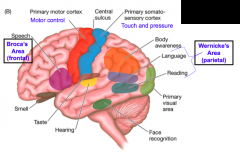
what happen to patient with damaged Brocca's area ? |
- Brocca's area is responsible of the ability to form speech - if damaged, patient can still understand speech and read normally but speech can't be made properly |
|
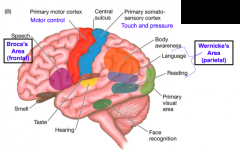
What happen to patient with damaged Wernick's area ? |
- Wernick's area is responsible of the ability of understanding speech - if damaged, patient will not be able to understand speech or read, even though speech-like sound can be made it will not be understandable. |
|
|
Provide an example of sensory neutron and explain how it's function differs from an afferent/efferent neurone. |
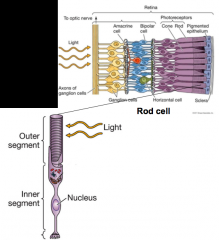
- Rod cells, is a sensory cell. - outer segment receives light and converts the external environment information into action potential at inner segment - neurons, afferent neurones receives sensory info and send to CNS and efferent cells transmit the info away from CNS - neurones only transmit action potential but sensory cells convert external stimulation into action potential |
|
|
what 3 types of ion channels are there on the plasma membrane that are involved in creating action potential. |
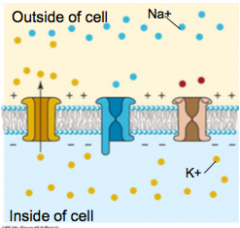
- K+ channel (leaky) - voltage-gated Na+ channel - chemically gated K+ channel |
|
|
what are the 3 stages in the process of creating action potential? |

- resting potential - depolarisation - hyperpolarisation |
|
|
what is membrane potential ? |
membrane potential is electric charge difference across the plasma membrane |
|
|
what happened during depolarisation ? |
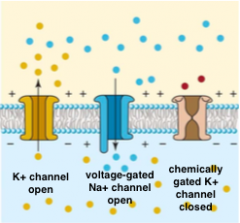
- k+ channel (leaky one) is open - Voletage gated Na+ channel is open - K+ leaves and Na+ enters the cell - Leading to lesser negative charge building up in the inner part of the membrane |
|
|
What happens during hyperpolarisation ? |
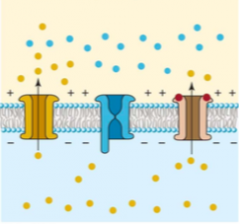
- K+ channel (leaky) is open - voltage- gated Na+ channel is closed - Chemically gated K+ channel is open - the membrane becomes more negative as more and more K+ leaves the cell |
|
|
what happened at synaptic cleft when signal has to be passed across neurones ? |
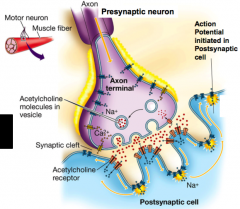
- at presynaptic neurones, when signal arrives, ion channels are ready to give an influx of calcium - calcium stimulates vesicle containing Acetylcholine (Ach) molecules - the contain will then be release at the cleft through exocytosis - Ach then binds to the receptors on postsynaptic cells which will trigger action potential to be made |
|
|
How does Acetylcholine creates action potential ? |
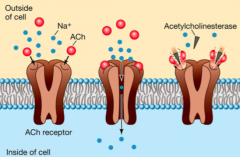
- Acetylcholine binds to its receptor and cause the receptors to change shape - opening the gate, allowing Na+ to enter - leading to depolarisation - creating membrane potential |
|
|
what is the purpose of axon hillock ? |

axon hillock is the region where all information collected by dendrites being integrated and initiated action potential |
|
|
what 3 types of systems are there in nervous system ? |
- central nervous system - peripheral nervous system - autonomic nervous system |
|
|
what 2 other sub-systems are under autonomic system ? |
- parasympathetic NS: causes stimulation action - sympathetic NS : cause inhibition action |
|
|
Describe the different region of cerebral hemispheres. |
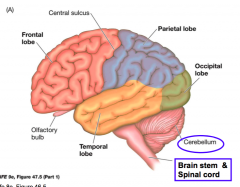
- frontal lobe, parietal lobe, temporal lobe, occipital lobes, - left and right cerebral hemisphere |
|
|
what is Ganglia ? |
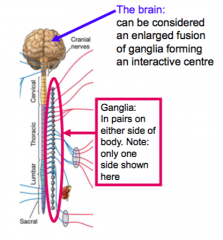
|

